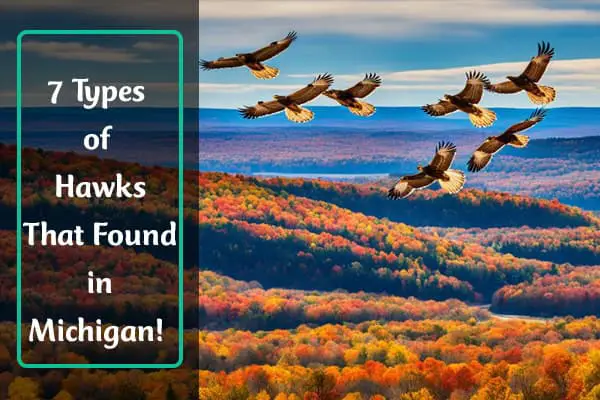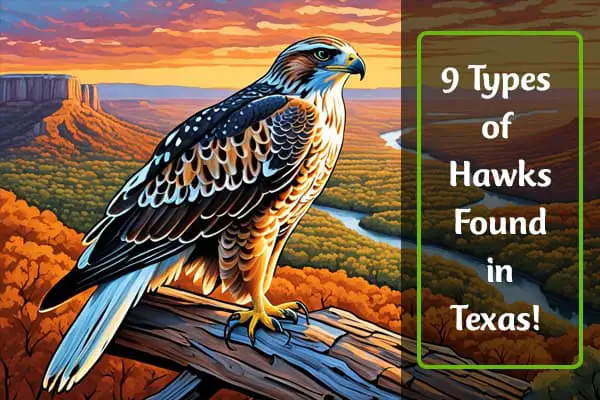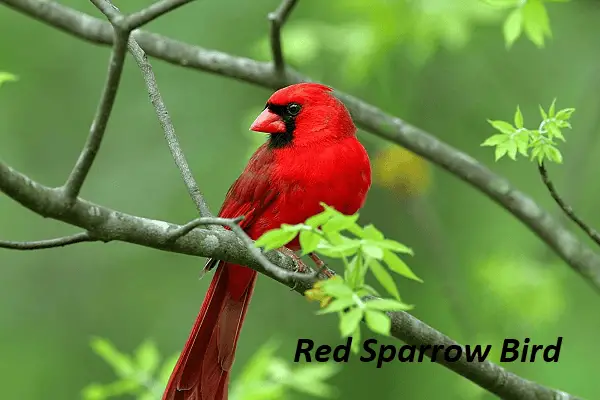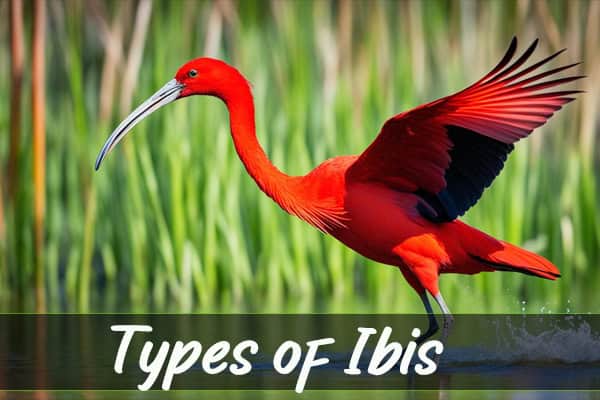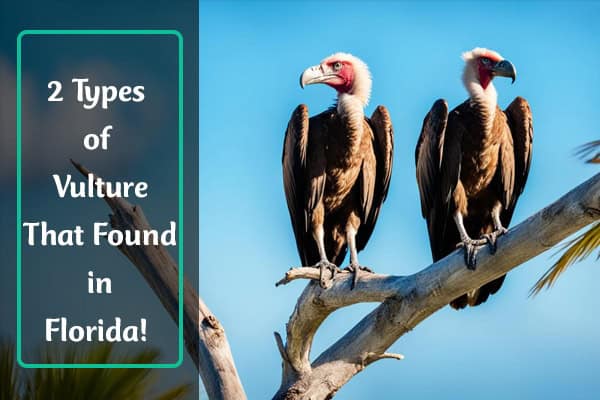Hawks in Michigan (7 Species With Pictures)
Hawks in Michigan are home to eight different species. These birds are known for their sharp beaks and swift movements. They are a key part of Michigan’s wildlife.
From the Red-tailed Hawk to the Northern Harrier, each hawk plays a key role in the ecosystem. Some live here all year, while others visit during certain seasons. Learning about these birds can inspire us to protect them.
Are you ready to learn more about Michigan’s hawks? Let’s explore the fascinating world of these birds together.
Hawks in Michigan
Michigan is a paradise for bird lovers, hosting a wide variety of hawk species. These birds, known for their sharp vision and hunting skills, fly over the state’s diverse landscapes. They include the famous Red-Tailed Hawk and the rare Sharp-Shinned Hawk. Each hawk species in Michigan is crucial to the balance of nature.
More than a dozen birds of prey live in Michigan, with hawks, falcons, eagles, vultures, and owls being common. Hawks like the Red-Tailed Hawk, Sharp-Shinned Hawk, Cooper’s Hawk, Red-Shouldered Hawk, Broad-winged Hawk, and Rough-Legged Hawk call Michigan home. Each hawk has its own special traits, behaviors, and places it likes to live, adding to Michigan’s bird diversity.
1. Red-shouldered Hawk
- Scientific name: Buteo lineatus
- Life span: 19 years
- Size: 43-61 cm
- Weight: 486-774 g
- Wingspan: 94-111 cm
In Michigan, the red-shouldered hawk is a common sight in forests and swamps. The state’s diverse landscape is perfect for these birds of prey. They are known for their reddish-brown shoulders and long, striped tails.
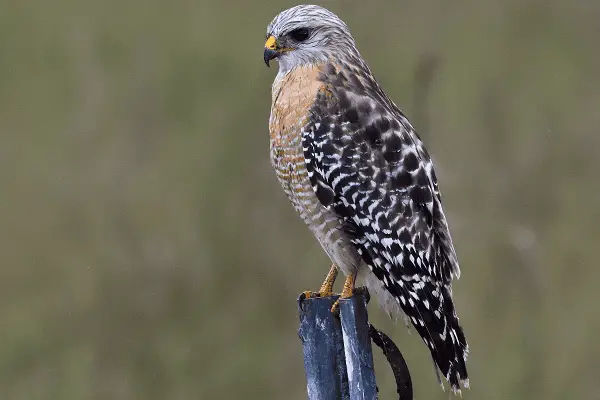
Identifying Features and Range
Red-shouldered hawks have a brown head and a pale, striped chest with reddish patches on their shoulders. Their long tails are a key feature that makes them stand out. These birds live throughout Michigan, especially in the northern parts. They prefer forested and wetland areas.
Nesting Habits and Courtship Rituals
- Red-shouldered hawks return to the same nesting territory year after year. One bird in southern California stayed in the same spot for 16 years.
- The oldest known red-shouldered hawk was a female, at least 25 years and 10 months old when recaptured and released again.
- Nestling red-shouldered hawks can shoot their feces over the nest edge by the time they are five days old, a remarkable adaptation.
Diet
Red-shouldered hawks are skilled hunters in the woods. They prey on small mammals, birds, amphibians, and reptiles. They use their sharp talons and keen eyesight to catch their prey from the trees. These raptors play a vital role in Michigan’s ecosystem, keeping the food chain balanced.
| Subspecies | Characteristics |
|---|---|
| West Coast form | Separated from the eastern forms by 1600 km (1000 mi) |
| Northern form | The largest of the subspecies |
| Southern Florida form | The palest, with a gray head and very faint barring on the chest |
2. Northern Harrier
- Scientific name: Circus hudsonius
- Life span: 12 years
- Size: 46-50 cm
- Weight: 300-750 g
- Wingspan: 102-118 cm
In Michigan, the Northern Harrier is known as the “Gray Ghost” of the skies. This large hawk lives in the state all year, breeding in the north and staying in the south through the seasons.
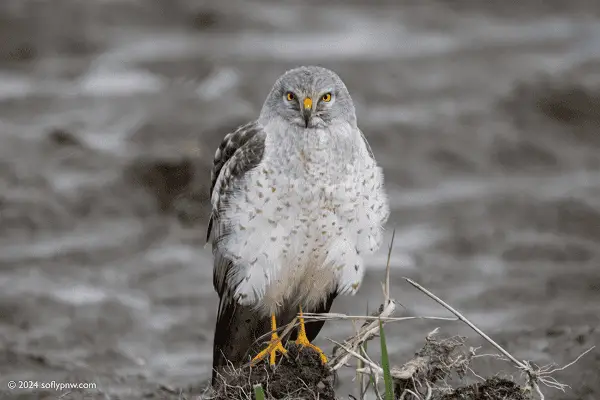
This hawk is big and has an owl-like face and long wings. You’ll see them flying low over marshes and prairies, looking for small animals, birds, and reptiles. Their gray color and owl-like face make them look like ghosts as they move across the sky.
Northern Harriers hunt using their hearing more than their sight. They have a special face that helps them hear prey from far away. This makes them great hunters in open areas.
When you’re out in Michigan’s nature, look for the northern harrier. These “Gray Ghosts” are amazing birds that fit perfectly into Michigan’s open lands. They show how rich and diverse Michigan’s nature is.
3. Red-Tailed Hawk
- Scientific name: Buteo jamaicensis
- Life span: 10-15 years
- Size: 50-65 cm
- Weight: 900-1460 g
- Wingspan: 114-133 cm
The red-tailed hawk is a common sight in Michigan, flying over fields, forests, and cities all year. It’s a big hawk with a reddish-brown tail and dark brown feathers on top. It’s a symbol of Michigan’s rich wildlife.

Breeding Season and Nest Construction
Red-tailed hawks usually mate for life and return to the same nest every year. In spring and summer, they build big nests in tall trees. The female lays 2-3 eggs, which she incubates for 30 days before they hatch.
Prey and Hunting Strategies
These hawks eat a variety of things like small mammals, birds, reptiles, and even dead animals. They have great eyesight and can spot prey from high above. They swoop down to catch their food. Their high-pitched call can be heard across Michigan.
Keep an eye out for the red-tailed hawk whether you’re in nature, hiking, or just looking up. This bird is a symbol of Michigan’s rich bird life.
4. Cooper’s Hawk
- Scientific name: Accipiter cooperii
- Life span: 12 years
- Size: 37-39 cm
- Weight: 220-410 g
- Wingspan: 62-90 cm
- Status: Least Concern
The Cooper’s Hawk is a medium-sized bird of prey found across North America, even as far south as Mexico. This remarkable raptor is known for its exceptional agility and ability to hunt prey much larger than itself. Adept at navigating through dense forests, the Cooper’s Hawk is a formidable woodland predator that has captured the attention of birdwatchers and nature enthusiasts alike.

Appearance and Behavior
With their short, broad wings and long, narrow tails, Cooper’s Hawks are often confused with their close relative, the Sharp-Shinned Hawk. However, a closer look reveals their distinctive features. Adult Cooper’s Hawks have a striking eye-catching pattern on their chests, while juveniles have a more mottled appearance with a hooded look and streaked cheeks.
These hawks are renowned for their incredible flying prowess, able to execute rapid, agile maneuvers to catch their prey. They are known to frequent backyard bird feeders, waiting patiently to ambush the smaller birds that visit, which can sometimes make them unpopular with homeowners.
Nesting
Cooper’s Hawks typically build their nests in the canopy of deciduous or mixed forests, often reusing the same nest site year after year. During the breeding season, these raptors engage in impressive aerial displays, performing acrobatic dives and wing-clapping to establish and defend their territories.
The Cooper’s Hawk is a fascinating raptor that exemplifies the beauty and adaptability of Michigan’s diverse avian predators. Whether you’re an avid birdwatcher or simply appreciate the wonder of nature, keeping an eye out for this agile woodland hunter is a rewarding experience.
5. Sharp-Shinned Hawk
- Scientific name: Accipiter striatus
- Life span: 5 years
- Size: 24-34 cm
- Weight:87-218 g
- Wingspan: 43-56 cm
Hawks In Michigan, the sharp-shinned hawk is the smallest around. They have grayish backs and bright orange chests. It’s easy to confuse them with the bigger Cooper’s hawk at first glance. But, they have a unique striped tail that makes them stand out.
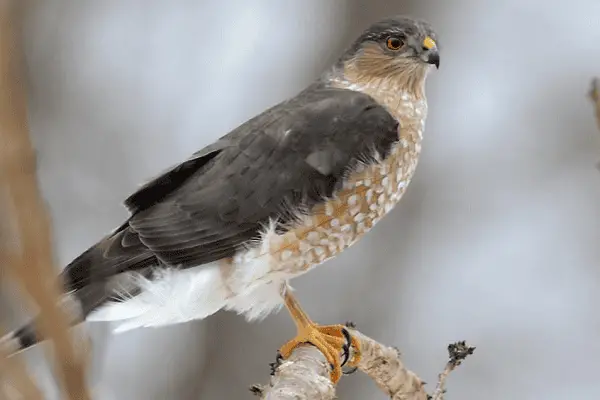
Mating Rituals and Nest Sites
During the breeding season, males show off with dramatic flights to find a mate. They build their nests high in dense forests. The females are about a third bigger than males, helping them catch larger prey.
Prey and Hunting Techniques
Sharp-shinned hawks are great hunters, chasing songbirds through the woods. They fly low and fast to catch their prey. Sometimes, they even visit bird feeders in the off-season for a snack.
“The distinctive flight style of a Sharp-Shinned Hawk includes a few quick wingbeats followed by a short glide.”
Even though they’re small, sharp-shinned hawks are important in Michigan’s ecosystem. Learning about their unique traits helps us value Michigan’s diverse wildlife.
6. Broad-Winged Hawk
- Scientific name: Buteo platypterus
- Life span: 12 years
- Size: 34-44 cm
- Weight: 265-560 g
- Wingspan: 81-100 cm
When autumn comes to Michigan, bird lovers look forward to seeing the broad-winged hawk. These birds are a highlight of the season. They travel from their summer homes to their winter spots in South America.

The broad-winged hawk has a dark brown body and a light-colored belly with dark bars. In spring and summer, they can be seen in Michigan’s varied landscapes. But in fall, they gather in huge groups, called “kettles,” and fly across the sky.
Between September 10 and September 20, these hawks migrate in large numbers. They are a sight to see as they fly. These hawks save energy by flying long distances with little effort.
Watching these hawks migrate is a special event for people in Michigan. At places like Putney Mountain, up to 500 to 1,000 hawks can be seen in one day. Their large groups flying together make a beautiful sight.
Their migration is not just a beautiful sight. It shows how amazing these birds are. Some hawks travel over 9,700 miles from Peru to Maryland and back each year.
Check Our Previous Articles:
7. Rough-legged Hawk
- Scientific name: Buteo lagopus
- Life span: Up to 15 years
- Size: 46-51 cm
- Weight: 680-1470g
- Wingspan: 132-137 cm
In Michigan, the Rough-Legged Hawk is a standout for its survival in the Arctic. This medium-sized hawk comes to the state from its Arctic home during winter.
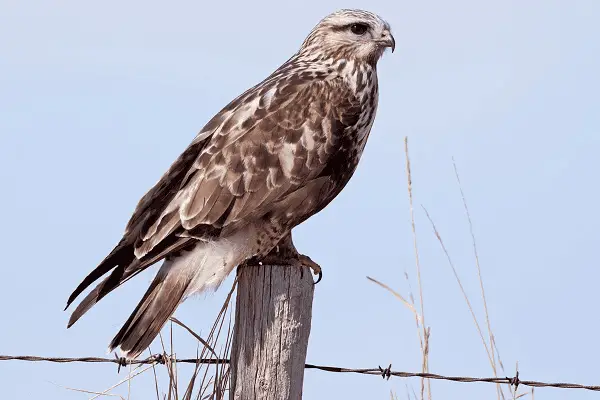
Nesting Habits
Unlike other hawks in Michigan, the Rough-Legged Hawk nests in the Arctic tundra and taiga. They lay 3-5 eggs on cliffs or tall trees. Their nests are in remote areas of North America and Eurasia, far from Michigan’s cities and forests.
The Rough-Legged Hawk’s visit to Michigan shows its amazing adaptations and migration skills. As they fly over the state, they connect us to the Arctic’s harsh beauty. This reminds us of Michigan’s rich bird diversity.
Frequently Asked Questions:
Q1. What kind of hawks does Michigan have?
Michigan is home to several types of hawks, including the Red-tailed Hawk, Cooper’s Hawk, and Sharp-shinned Hawk.
Q2. Are hawks good to have around?
Yes, hawks help control the population of rodents and other small animals, contributing to a balanced ecosystem.
Q3. What is the difference between a hawk and a falcon?
Hawks are generally larger with broader wings and tails, while falcons are smaller, with slender bodies and pointed wings. Falcons are also faster and have a distinctive hunting style, diving at high speeds to catch prey.
Q4. What are hawks famous for?
Hawks are famous for their keen eyesight, powerful talons, and their ability to hunt and capture prey with precision.

